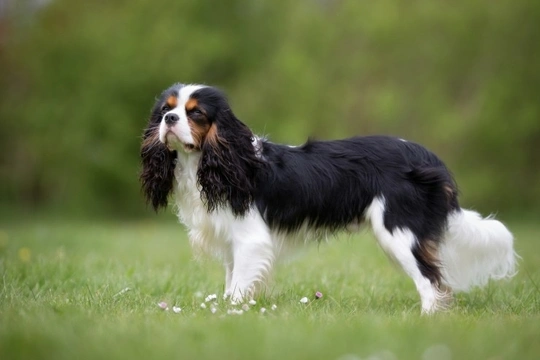Pets
Pets for studWanted petsBreedersAccessories & services
Knowledge hub
Support
Support & safety portal
Curly Coat/Dry Eye (CC/DE) testing for Cavalier King Charles spaniels
Curly Coat/Dry Eye (CC/DE) is a dual-pronged condition that can affect the Cavalier King Charles spaniel dog breed, resulting in the concomitant presentation of the conditions congenital keratoconjunctivitis sicca (dry eye) and ichthyosiform dermatosis, or curly coat. The combined condition is only found in the Cavalier King Charles spaniel breed, and sadly, usually results in affected dogs being put to sleep to prevent future pain and suffering.
Fortunately, the condition can be prevented by means of DNA testing for potential parent dogs of the breed, which allows breeders to make an informed decision about the viability of their dogs’ ability to produce healthy puppies that will not themselves develop the condition.
For this reason, The Kennel Club, in association with the British Veterinary Association, holds a database of health test results for dogs of the breed to make selecting a potential mate for breeding stock easier. Additionally, anyone who is considering breeding from their own Cavalier King Charles spaniel is advised to have their own dog tested too, to ensure that the litter will not be affected.
In this article, we will look a Curly Coat/Dry Eye in the Cavalier King Charles spaniel in more detail, including how it affects the dogs that inherit it and how it can be tested for. Read on to learn more.
More about Curly Coat/Dry Eye
Whilst the two respective conditions of curly coat and dry eye can be found across various other dog breeds, the hereditary combination of both issues together is unique to the Cavalier King Charles spaniel dog breed. Additionally, dry eyes and a curly coat might not seem to be major health problems in the greater scheme of things, and so the impact that they can have on affected dogs is often overlooked-but dry eye in dogs can lead to a range of painful and debilitating problems such as ulcerated corneas and ultimately, blindness, while a curly coat is less a descriptive of the coat’s texture, and more a range of chronic problems caused by the gene that leads to the coat’s signature curl.
Curly coat does not just affect the coat itself-it can also lead to problems with the skin on the dog’s paws, nose and other areas that are not covered with fur, such as a thickening and hardening of the skin itself, and a wide range of other issues that can be both painful, debilitating, and apt to lead to secondary complications such as infections.
What sort of dogs can be affected by the condition?
Curly Coat/Dry Eye found together is unique to the Cavalier King Charles spaniel dog breed, although both conditions alone can be found across a wide number of other dog breeds too. Whilst it is not thought that a significant number of Cavvies are currently affected by the condition, because it is chronic and so debilitating to the point that its impact on the dog’s quality of life may lead to euthanasia, all potential breeding stock from the breed should be tested for the markers of the condition before breeding.
The condition affects males and females equally, and it is usually evident at birth if the condition is present in any given dog, as they will be born with a curly and very dry coat, as well as almost immediately displaying the indications of eye discomfort due to the lack of appropriate lubrication in the eyes.
How does the heredity of CC/DE work?
Curly Coat/Dry Eye in dogs is an autosomal recessive hereditary condition, which means that it cannot be caught or transmitted from dog to dog like a contagious condition, but instead, must be inherited. The condition is passed on through the genes, and depends on the parent dogs having the mutated genes that are the signature of the condition themselves, and then passing them on to their young.
However, just because one parent dog is affected by the condition or carries the markers for it does not necessarily mean that their offspring will be affected too-a dog must inherit two of the faulty genes, one from their mother and one from their father, in order to be affected.
If only one parent dog passes on the gene, the litter produced will not be symptomatic themselves, but will become carriers for it and so, be able to pass on the trait to their own offspring.
If neither parent dog is carrying the condition, it cannot be passed on.
How does the test for the condition work?
Pre-breeding screening for the markers of the condition-either as a carrier or as an affected dog-should be carried out before making the decision to breed from any given dog, to avoid passing the condition on.
In order to have your dog tested for the condition, all that is needed is a buccal sample-a swab of the skin cells on the inside of your dog’s cheek-and these can then be assessed in a laboratory, with the results returned to you.
For a details of the laboratories that can carry out the test, see The Kennel Club’s authorised laboratories list.



